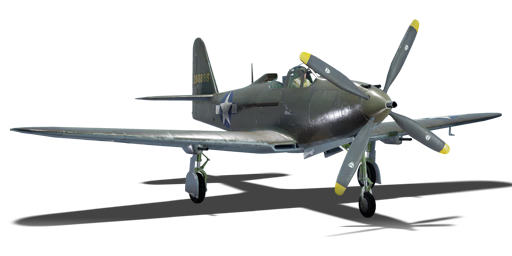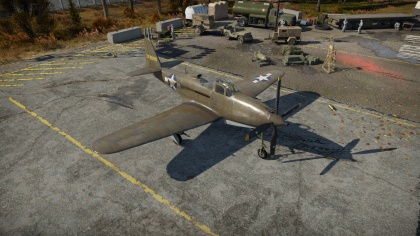P-63A-5
Contents
| This page is about the American fighter P-63A-5. For other uses, see P-63 (Family). |
Description
The P-63A-5 Kingcobra is a rank III American fighter
with a battle rating of 3.7 (AB/SB) and 3.3 (RB).
General info
Flight Performance
| Characteristics | |||||||
|---|---|---|---|---|---|---|---|
| Stock | |||||||
| Max Speed (km/h at 6,850 m) |
Max altitude (meters) |
Turn time (seconds) |
Rate of climb (meters/second) |
Take-off run (meters) | |||
| AB | RB | AB | RB | AB | RB | ||
| 618 | 598 | 12200 | 22.0 | 22.7 | 16.1 | 16.1 | 289 |
| Upgraded | |||||||
| Max Speed (km/h at 6,850 m) |
Max altitude (meters) | Turn time (seconds) | Rate of climb (meters/second) |
Take-off run (meters) | |||
| AB | RB | AB | RB | AB | RB | ||
| 671 | 640 | 12200 | 20.3 | 21.0 | 24.1 | 19.6 | 289 |
Details
| Features | ||||
|---|---|---|---|---|
| Combat flap | Take-off flap | Landing flap | Air brakes | Arrestor gear |
| ✓ | ✓ | ✓ | X | X |
| Limits | ||||
|---|---|---|---|---|
| Wing-break speed (km/h) |
Gear limit (km/h) |
Combat flap (km/h) |
Max Static G | |
| + | - | |||
| 0 | 304 | 480 | ~15 | ~7 |
| Optimal velocities | |||
|---|---|---|---|
| Ailerons (km/h) |
Rudder (km/h) |
Elevators (km/h) |
Radiator (km/h) |
| < 430 | < 430 | < 419 | > 250 |
| Compressor (RB/SB) | ||
|---|---|---|
| Setting 1 | ||
| Optimal altitude | 100% Engine power | WEP Engine power |
| 6,600 m | 1,170 hp | 1,486 hp |
Survivability and armour
- 15.87 mm Steel - Plates x 2, lower fore cockpit
- 19.05 mm Steel - Plate, upper fore cockpit
- 12.7 mm Steel - Plate behind pilot's seat
- 12.7 mm Steel - Plate protecting oil cooling system
- 38 mm Bulletproof glass - Windscreen
Armaments
Offensive armament
The P-63A-5 is armed with:
- 1 x 37 mm M10 cannon, nose-mounted (58 rpg)
- 2 x 12.7 mm Browning M2 machine guns, nose-mounted (250 rpg = 500 total)
- 2 x 12.7 mm Browning M2 machine guns, wing-mounted (200 rpg = 400 total)
Suspended armament
The P-63A-5 can be configured with the following ordinance:
- Without load
- 1 x 500 lb AN-M64A1 bombs (1,500 lb total)
Usage in the battles
This aircraft is a good all-altitude fighter. The A-10 can out-climb most of its opponents, un-upgraded, although "side climbing" is recommended when the higher altitudes are reached. Its straight line speed, especially at higher altitudes, is respectable, competing with 109s of the tier. This aircraft has a poor turn-time at slower speeds, but as with most US aircraft, its high-speed performance is significantly better than the aircraft it faces, making it a good Boom & Zoom aircraft. The improved 37 mm gun improves damage to aircraft since the 4 x 12.7 mm Brownings are not greatly powerful at the higher tiers- the 37mm gun compliments the 12.7mms as a good bomber hunter, combined with the sleek profile of the aircraft. The aircraft is not intended, nor should be used, as a ground attack vehicle, since it can only carry one, 500lbs bomb and the ammunition count for the 12.7 mm guns is not great, 250 rpg- the 37 mm gun can be used as ground attack, although this tactic isn't preferred by some as it reduces the ammo count as a whole for the aircraft, which is one of its limiting factors in combat. Tactically, the aircraft is good for small dives against turn-fighting opponents on the tail of your allies, from around 1,000 m or less above the target. Keeping any "side-climbers" down is normally good since the speed and rate of climb allow the P-63 to catch these planes and send them back down.
An interceptor in any respect. Unlike most American designs the Kingcobra lacks heavy payload for ground attack duties. While the 37mm can load anti-tank rounds, the plane will lose its excellent anti-air HE shells. Of course, the 12.7 heavy machine guns can be used against planes, in a ground attack role they are rather used on soft targets, as the AP shell lacks high-explosive damage radius to deal with AAA & SPAA quickly. The AP shells also require more accuracy while shooting and thus are inferior to the .50 cal Brownings on range e.g. with the HMG effective fire against light targets is possible from 600 m, but with the 37mm AP shells, this needs to be reduced to 400 m.
Manual Engine Control
| MEC elements | ||||||
|---|---|---|---|---|---|---|
| Mixer | Pitch | Radiator | Supercharger | Turbocharger | ||
| Oil | Water | Type | ||||
| Controllable | Not controllable | Not controllable | Controllable | Combined | Not ontrollable | Not controllable |
Modules
| Tier | Flight performance | Survivability | Weaponry | ||
|---|---|---|---|---|---|
| I | Fuselage Repair | Radiator | Offensive 12 mm | ||
| II | Compressor | Airframe | New 12 mm MGs | FMBC mk.1 | |
| III | Wings Repair | Engine | Offensive 37 mm | ||
| IV | Engine Injection | Cover | New 37 mm cannons | ||
Pros and cons
Pros:
- Powerful 37 mm cannon with 4 x 12.7 mm machine guns as a backup
- Slightly more powerful engine and better manoeuvrability than the already well performing P-39Q Airacobra
- Can WEP for a long time without overheating
- Jack of all trades
Cons:
- Limited 37 mm ammo
- Bigger target than the P-39Q
- Still stuck with the same M4 cannon as the P-39's
- Slow fire rate for the 37 mm cannon
- 37mm projectiles are still too slow and inaccurate to be reliably effective in a dog fight
- 37mm projectiles can still not penetrate tank armour even at optimal angles
- Centre mounted engine has a higher tendency to take damage in pursuits and from diving planes.
History
Describe the history of the creation and combat usage of the aircraft in more detail than in the introduction. If the historical reference turns out to be too big, take it to a separate article, taking a link to an article about the vehicle and adding a block "/ historical reference" (example: https://wiki.warthunder.com/Name-vehicles/historical reference) and add a link to it here using the main template. Be sure to include links to sources at the end of the article.
In-game description
"Bell P-63A-1/A-5 (Model 33) Kingcobra Army Fighter
A single-seat, closed-canopy, all-metal monoplane fighter with retractable landing gear and a nose strut. The P-63 Kingcobra was developed as an improved version of the P-39 Airacobra and had a similar layout, with the engine located just behind the cockpit.
Work on the plane, originally designated the XP-39E, began in February 1941. The first prototype, designated XP-63, flew on December 7, 1942, and production of the P-63A-1 (Model 33) began in October 1943, along with the P-39.
The general layout of the P-39 Kingcobra was preserved, but the P-63 featured new, streamlined wings. In order to remedy the P-39's main weakness, a propensity to falling into a flat spin, the area of the vertical tail fin was increased and the aft section of the fuselage was lengthened.
The first production models were equipped with a V-12 liquid-cooled Allison V-1710-93 engine (1325 hp). The aircraft was armed with a Colt-Browning M4 37mm machine gun with 30 rounds and 2 synchronous Colt-Browning M2.5 12.7mm machine guns with 270 rounds per gun. An additional two M2.5s with 250 rounds each were placed in the wing compartments.
Aircraft of both series (except some A-1 planes) were fitted with a ventral pylon which could hold a fuel tank of 75 gallons (284 liters) or one 500-lb (227-kg) bomb.
The aircraft was continually tweaked from one production run to the next, improving its ability to support troops on the field. However, the differences between the A-1 and the A-5 were only slight. The most significant difference, though not a visible one, was the increase in armor from 40 kilograms to 81. 50 P-63A-1 and 20 P-63A-5 planes were produced.
The Red Army became the main consumers of the P-63A. Deliveries to the Soviet Union began in the summer of 1944, via Alaska and the Northwest Staging Route. The P-63A began to support Soviet anti-aircraft operations in the spring of 1945.
The Soviet version of the P-63A differed from the American in one important feature: the presence of a crank to start the engine. In addition, the Soviets equipped the plane with FAB-100 and FAB-250 bombs under the fuselage."
Media
An excellent addition to the article will be video guides, as well as screenshots from the game and photos.
Read also
Links to the articles on the War Thunder Wiki that you think will be useful for the reader, for example,
- reference to the series of the aircraft;
- links to approximate analogues of other nations and research trees.
Sources
Paste links to sources and external resources, such as:
- topic on the official game forum;
- page on aircraft encyclopedia;
- other literature.
| USA fighters | |
|---|---|
| P-26 Peashooter | P-26A-33 · P-26A-34 · P-26A-34 M2 · P-26B-35 |
| P-36 Hawk | P-36A · Rasmussen's P-36A · P-36C · ○P-36C · P-36G |
| P-39 Airacobra | P-400 · P-39N-0 · P-39Q-5 |
| P-40 | P-40C · P-40E-1 · P-40E-1 TD · P-40F-10 |
| P-43 Lancer | P-43A-1 |
| P-47 Thunderbolt | P-47D-22-RE · P-47D-25 · P-47D-28 · P-47M-1-RE · ⋠P-47M-1-RE · P-47N-15 |
| P-51 Mustang | P-51 · P-51A (Thunder League) · P-51C-10 · P-51D-5 · P-51D-10 · P-51D-20-NA · P-51D-30 · P-51H-5-NA |
| P-63 Kingcobra | P-63A-5 · P-63A-10 · P-63C-5 · ␠Kingcobra |
| Prototypes | XP-55 |
| F2A Buffalo | F2A-1 · Thach's F2A-1 · F2A-3 |
| BF2C | BF2C-1 |
| F3F | F3F-2 · Galer's F3F-2 |
| F4F Wildcat | F4F-3 · F4F-4 |
| F4U Corsair | F4U-1A · F4U-1A (USMC) · F4U-1D · F4U-1C · F4U-4 · F4U-4B · F4U-4B VMF-214 · F2G-1 |
| F6F Hellcat | F6F-5 · F6F-5N |
| F8F Bearcat | F8F-1 · F8F-1B |
| Other countries | ▃Ki-43-II · ▃Ki-61-Ib · ▃A6M2 · ▃Bf 109 F-4 · ▃Fw 190 A-8 · ▃Spitfire LF Mk IXc |





